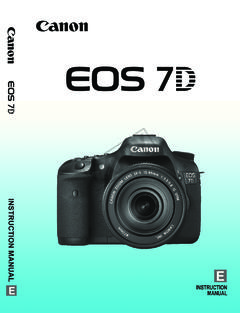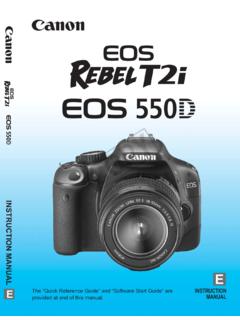Transcription of A beginners guide to Canon’s Digital Photo Professional 4
1 A beginners guide to Canon sDigital Photo Professional 4 Especially written for Canon EOS users2020 Revision DPP Version Nina Bailey Original imageWith WB adjustmentWith basic adjustments2 About the authorNina started her career in the retail sector of the photographic industry and then moved to Canon UK where she had a successful nine years looking after training, exhibitions and marketing both in the UK and also within Europe. This gave Nina an unrivalled knowledge of not only the Canon EOS system but also how to develop and enhance the skills of photographers of all ability levels. Whilst working at Canon Nina worked on the very first Digital camera models, both compact and D-SLR, to enter the market and this has given here a unique insight about the work-flow and processing for Digital started her own business in 1999, concentrating on training for amateur photographers.
2 She is also at the forefront in developing and producing the new Online EOS Training Academy. As well as developing the online training academy and direct training of photographers, Nina is a prolific Professional photographer producing images not only for the EOS Training Academy but for a variety of outside 2014 Nina started producing her own range of ebooks to bring photography training to an ever wider audience. Nina writes, shoots, produces all graphics and designs all the layouts of the books herself and this gives her a very good in-depth understanding of all the processes involved in producing Digital images and how they are used. In Summer 2015 Nina was appointed as Technical Editor of EOS Magazine, a role that she is doing in addition to her active role as the principal lecturer for the EOS training Academy and writing her started taking images when she was very young and is still a very keen photographer both professionally and personally.
3 Nina loves travel, landscape and wildlife photography and still occasionally shoots commercially within the travel photography market. However, most of the images she now shoots are for her own picture library for use in the books and articles that she , designed and images by Nina Bailey by Nina Bailey 2020. All rights reserved. Unauthorised copying, reproduction, hiring, lending prohibited. E& : Some of the locations that my quest for images have taken me to along with some of the encounters with the local wildlife along the way. ContentsPREVIEW EDITION3 What s changed in this versionThis book has been written based on the 2020 version ( ) of the Digital Photo Professional 4 program which was launched to go with the EOS 1DX Mark III.
4 If yours is not the latest version, it can easily be updated for free from the Canon website. For those that have had several versions of the book (each time I update the DPP 4 book you get an invitation to update to the latest version for free providing you are on our email mailing list). I normally try and list where the main changes are, but this is a major update and I have added pages and amended text to reflect new options and changes within the EOS market, so there is not space to list all of it so have a flick through to see what s new. This has been a little bit more involved as an update as I have reformatted the text and layout a little bit. I have also added a reference section at the start which is bringing it into line with a lot of the other new books I ve released recently.
5 The main additions from the program s point of view is adding in the RAW burst feature, which is currently only found on the EOS M6 Mark II, though in the normal fashion I m sure it s going to be on lots of other models shortly. I am also adding in the details for High Dynamic Range Perceptual Quantizer (HDR PQ) processing and the new High Efficiency Image File Format (HEIF). Currently this only apply to a relatively small number of models, however it s very clear from some of the information coming out from Canon that it s going to provide the new standard in the future. The final item is the new Clarity option, which at the time of writing is only found on the EOS 1DX Mark III.
6 However, in the coming months we expect to see it appear on other models. I have also updated and expanded the section on the Digital Lens Optimization feature. This has now become a standard feature on the EOS R series mirrorless models and the latest M and dslr models appearing from late 2019 onwards. It is now turned on as standard and so is worth a more significant inclusion, especially with the EOS R system, because on some of the RF lenses it is now a very necessary feature. Digital Photo Professional software can be easily downloaded from the Canon website, look for support and then go to the software section. Make sure you have your camera s serial number to hand as you will need to enter it to download the free software.
7 There is a minimum screen resolution for this program which is: XGA (1,024 x 768) or more (1,600 x 1,200 or more recommended). Most computers will easily fulfill this but be aware that some netbooks and ultra small screen laptops may be too low and if so, the program will not load. It does not matter what operating system you use, as Digital Photo Professional looks and works identically on both PC and Mac. I use a Mac and so the screen grabs are from a Mac system. If there are differences, for example when the keyboard shortcuts are different, I will explain this in the book. ContentsPREVIEW EDITION7 About Digital Photo Professional 10 DPP system requirements 11 Where DPP should be installed and images stored 12 Compatible cameras and images 13 Introduction 14 Introduction 15 Benefits of using DPP 17 Changing times 18 Reference section 19 Camera launch dates and DIGIC types 20 Computer requirements
8 21 Mac vs PC 22 Monitors 23 Colour space 24 Colour management 25 Other colour management terms you may see 26 What is work-flow 27 Downloading images 28 Filing images 33 Destructive and non-destructive adjustments 36 Common file types within post-production 37 HEIF format 40 Bit depth of images 41 About 10-Bit images 43 Backing up your images 44 Work-flow thought process 45 Understanding RAW and JPEG options 46 Image quality - RAW 47 New C RAW format 49 How C RAW works 50 C RAW Testing
9 51 How to tell RAW and C RAW apart 54 File formats - JPEG 55 JPEG saving options 57 Postproduction and JPEG images 58 RAW vs JPEG - what is best 59 Summary 60 Getting familiar with DPP 61 Getting familiar with DPP 62 About the message 63 Finding and displaying your images 64 Choosing the order of images 66 Freehand ordering 67 Bookmarks 68 About the Multi Layout window tool bar 69 Additional options to be aware of 70 About the thumbnails control panel 71 Filter options 74 About the thumbnails control panel options 76 About the Multi Layout window 78 About the Multi Layout window - image comp 80 About the Multi Layout window - grid 81 About the Multi Layout window - AF point display 82 Multi Layout window - Highlight/shadow alert 83 About the Multi Layout window - Information 84 About EXIF information 85
10 Moving and filing images 86 A brief look at the menus - DPP Menu 87 A brief look at the menus - File Menu 90 A brief look at the menus - Edit / View Menu 91 A brief look at the menus - Thumbnail/Preview/Label 92 A brief look at the menus - Adjustment/Tools menu 93 A brief look at the menus -Window/Help/Cloud Menu 94 Sorting images using the Quick Check tool 95 Contents Basic editing of images 98 Basic adjustment of an image 100 Order of adjustments 101 Basic saving of finished images 102 Transfer to Photoshop option 104 Basic adjustments 106 Why we do adjustments 107 Advantages of RAW adjustments 108 Why Digital Photo Professional ?

